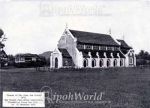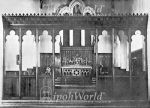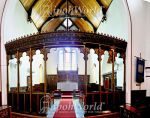We've tried to ensure the information displayed here is as accurate as possible. Should there be any inaccuracies, we would be grateful if you could let us know at info@ipohworld.org . All images and content are copyright.
(Please click on the thumbnail for a bigger image.)
Church Of St John The Divine (St John's Anglican Church)



To what we know, the earliest services for this Anglican community were in 1905 (there were no records prior to 1905). Early church records, however, state that a public meeting was held on 16 September 1905 to discuss matters relating to worship and administration of the church. By this time, there was already a sizeable community of worshippers. The chairman of the September meeting was Mr Edward John Brewster (who incidentally was the Chairman of the Kinta Sanitary Board from 1904 to 1910; Brewster Road in Ipoh was also named after him). The meeting was held at the former Ipoh Court House - at present, the Perak State Mosque occupies the area.
By 1906, monthly services were conducted by Rev. J. B. Bourne at the old wooden court house. This court house. which was opposite the Birch Clock Tower, was partly renovated to suit as a place of worship. There were only four services in a year, presided by Rev. Bourne who was the Chaplain from Taiping (under the North Perak Church). Being the only Chaplain, he was tasked with visiting and celebrating Holy Communion all over Perak. It was only in 1909 that the Chaplaincy of Southern Perak was inaugurated; until 1910 there were two services per month for the Ipoh community.
Later, as the number of members in the congregation grew, there was a need for a permanent church building. Rev. Bourne started a fund for this purpose, and his efforts were continued by Rev. J. P. Parry (who was stationed in Batu Gajah). The idea for a permanent building was also supported by the then British Resident of Perak - Sir Ernest W. Birch. On 15 December 1910, Bishop Charles James Ferguson Davie (from the Diocese of Singapore) laid the foundation stone of the future church. Among those who formed part of the Procession (and also witnessed the laying of the foundation stone) were: Rev. Frank W. Haines (Inspector of Schools and Colonial Chaplain of Penang); Canon Barton-Parkes (Chaplain of North Perak); Mr Spinks (Ipoh Church Building Committee Chairman); Mr Oliver Marks (Acting British Resident of Perak); Rev. Henham; Pragasam Sankey & Harold Donald Grenier Jansz (young boys who later became key figures in the church community); members of the South Perak Council and other church members.
The building, a bricks and mortar Gothic style architecture, was built at the corner of Kuala Kangsar Road (where it still stands today). The interior consisted of a middle and two-side aisle, chancel ,vestry and west-end porch. The chancel furniture and lectern was of polished oak (the lectern being a donation from a member of the congregation). Punkahs and oil lamps were first used; later replaced with proper lights with the introduction of electricity. The church was then built at the cost of $ 20 000. Bricks (from the earliest kilns in Perak) and cement were used for the building, with mortar for the walls. Interestingly, the mortar used was a combination of: fine sand, slaked lime, coconut fibre, sugar and egg-white! Cengal Batu wood was used for the structural beams while Meranti wood was used for the wall and ceiling. The roof has red Marseille tiles.
On the 30th of April 1912, the Church of St John the Divine was consecrated by Bishop Ferguson Davie. Years later, the bell tower and the organ loft were built. In 1917, there was an appeal for a Vicarage. 3 years later, Rev LS Kempthorne became the resident pastor at St Johns. During his term, the Vicarage was built (at the cost of $ 18 000) and it became a centre for parish activities. In 1925, Rev Graham White established the Chinese and Tamil Vernacular sections of the parish. He also established the Anglican School in Ipoh (in 1928).
During the Japanese Occupation, the church was damaged :
- On 26th Decemebr 1941, the nearby Shell Oil Depot was bombed by the Japanese. The depot was ablaze for 3 days.
- On that same day, an ammunition train near the Railway Station sidings was also bombed. The impact damaged the church and the vicarage. The explosion shattered the glass panes at the high altar; and a wheel from the locomotive hit the bell tower.
The Japanese considered the church as ‘enemy property’, and so it was used as a store house. Later, it was converted to a noodle factory. The Japanese officials occupied the vicarage. The community then had to attend services at the Church of the Holy Spirit in Buntong. Services there were conducted by Padre Samuel and assisted by HDG Jansz. The church was also looted thus loosing many valuable items.
Even the church pews were not spared – they were used for firewood! The marble base of the pulpit had also been destroyed. However, a set of photographs of the church’s early history and a Processional Cross were untouched; the Cross was presented by the Royal Society of St George in 1941, and was kept safely by one of the parishioners. This cross was later presented at the 1st service held after the Occupation (on 23rd September 1945).
In 1948, during the Malayan Emergency, numerous British regiments worshipped at St Johns. Military parades were a familiar sight in the church grounds during those times. A year later, the church was fully rehabilitated. That same year, Rev Anthony C Dumper served as the Vicar of South Perak. In January 1955, Rev Dumper was installed as the Archdeacon of North Malaya. His wife Mrs S Dumper was quite involved with the women’s work, both in the Parish and the Diocese.
It is said that the Dumper’s arrival was a “turning point” for St Johns. The congregation grew and a number of projects were carried out. Things like hymnals, linen, and other such paraphernalia were donated by the congregation. Rev Dumper later prompted the building of a Parish Hall; and, through many fund raising initiatives and donations from well-wishes, the $ 50 000 Hall was built. Rev Dumper even wrote a booklet entitled ‘A History of the Parish of South Perak’ and funds raised from the sale of this booklet also contributed to the building of the Hall.
St Johns also had a Kindergarten, which was under the leadership of Mrs Sarmukh Singh. She, and later Ms Stella Sankey, ran the kindergarten which saw an increase in enrolment – from the initial 10 students to 240! By the end of October 1985, 3 classrooms and an office block was added to the kindergarten (at the cost of $ 82 000). Today, the church still stands at St Johns Road (Jalan St John), almost across the road from the La Salle Centre (of St Michaels Institution). A recent (2009) fund-raiser, in a form of a concert, was organised for the benefit of restoring the church.
The first picture was taken in 1912, just after the church was completed.
James Devadason adds:
The Church was consecrated in 1912. During the 2nd World War the Japanese confiscated this church as enemy property as the King of England was the head of the Church of England. The Japanese converted it to a noodle factory. The pews were chopped up for firewood and only four survived.It did have a pipe organ but during the 2nd World War no one knows what happened to it.
I wish to add that the looters stole the brass lectern, candle sticks and the brass memorials. The only item that survived was the processional cross, the verger Andoo Nathaniel kept it in his house. The British returned to Ipoh in September 1945 and he presented the cross to the Chaplain. It was presented to the Church by the Royal Society of St George in April 1941- I hope that my memory serves me well.
Ipoh Remembered offers an amusing story:
"The congregation was more or less satisfied with the space they were given by government, but then two things happened: (1) more people started attending (at least on Sundays); and (2) The government allowed the Bank to use part of the same building. To some people the latter compromise was too much, so the agitation grew for a new church building and, as you know, one was ready in 1912."
Ipoh Remembered also adds:
Originally the church was said to be at the corner of Court Estate Road and Kuala Kangsar Road.
Later, that part of Kuala Kangsar Road was deemed to be part of Club Road; then in the mid-'30s it became Douglas Road; which then became part of Jalan Panglima Bukit Gantang Wahab.
Meanwhile, Court Estate Road originally went west from the church across the railway line, passed the old Supreme Court building (hence the name), and then turned north to meet Maxwell Road. But by 1930, FMS Railways had commandeered more land[See note 1] and Court Estate Road ceased to exist as such. The lower part still went west from the church but then it turned south (as it still does today). The upper part that connected to Maxwell Road became Charleton Road, a name it retains to this day (although the spelling may have "evolved").
Incidentally, Maxwell Road and Charleton Road were named for Eric Maxwell and his older brother Charleton.[See note 2]
[note 1] In fact it was the Railways that forced the abandoning of the old court building and the construction of the new one on Club Road.
[note 2] Charleton and his (Malay) wife were murdered in their bed in 1940. Their little daughter survived.
The second picture shows the chancel screen and sanctuary (1928). We thank Ipoh Remembered for this picture. He also adds that screen was donated by Alice and Arthur Towers.
The third picture shows the same chancel and sanctuary in 2011. This was taken from an article from the Ipoh Echo.
To see a photograph of the first Ipoh's first Courthouse that doubled as a church, click here.